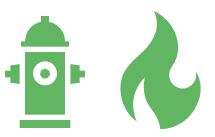Energy and Utilities

The Energy and Utilities sector includes all activities related to water supply, sewage services, electricity, dams, and natural gas. Climate-change-related risks affect water supply and utility infrastructures, as damages will have great impacts on operations and costs.
The use of climate services can contribute to a better management of water flow, more resilient and independent energy systems, informed purchasing decisions based on accurate predictions, and others.
Earth observation-based data, in particular, can be used into climate services aimed and forecasting and nowcasting, planning and optimisation of renewable energy (onshore and offshore wind, solar, tidal and wave), and monitoring of strategic for the utilities sector infrastructure (e.g. dams, pipelines).
Sustainable urban communities

Green and sustainable urban communities operate their human, natural, and financial capital with the goal to meet current and future needs in a sustainable manner, while prioritising a long-term perspective. This is particularly important against the backdrop of the ongoing climate crisis, due to the sustainable communities’ focus on anticipating and adapting to change in both the present and future. Moreover, the current reality of an increasing majority of the world’s population living in cities which in turn grow rapidly and not always sustainably, puts urban communities at the forefront for climate services related to resilience and adaptation.
Those using Earth observation data have prominent application when it comes to assessing and forecasting air quality and pollen concentration and assisting urban planning and operations (monitoring and preventing heat islands, building greener cities) and optimizing green cities, in particular when these are implementing elements of a smart (e.g., IoT) infrastructure.
Marine and coastal environment

Marine environments are aquatic environments with high levels of dissolved salt. These include the open ocean, the deep-sea ocean, and coastal marine ecosystems, each of which have different physical and biological characteristics, and thus representing different ecosystems.
Marine and coastal environments can host complex ecosystems whose fragile equilibrium and prosperity depends on numerous environmental factors influencing each other, and are thus a prime example of systematic approach to tackling climate needs (and providing corresponding services), making sure that addressing a single ecosystem indicator impacts other indicators in a foreseeable and favourable manner.
The climate services in the marine and coastal domain rely on Earth observation data for precise nowcasting and forecasting, informing ocean weather algorithms, and monitoring parameters influencing water quality (for health, tourism, reporting purposes), such as turbidity, (potentially harmful) algae blooms and others.
Agriculture, Forestry and other Land use

Agriculture, forestry, and other land uses (AFOLU) covers an array of environments and encompasses great potential and need for climate services. Unsustainable use of agricultural and forest practices (e.g. overexploiting the soil, converting forests into agricultural land) create huge amounts of greenhouse gases and disrupt the already fragile equilibrium in the local ecosystems (GEF).
Using sustainable forest and land management practices with a view on long term and systemic impact can instead help those ecosystems retain and store significant amounts of carbon and preserve their fragile equilibrium.
The products of these sustainable practices could then fuel bioeconomy – a corollary of circular economy, where renewable biological resources from land and sea (such as crops, forests, fish, animals, micro-organisms etc.) are used to derive products, processes and services in all economic sectors within the frame of a sustainable economic system. (EC, Bioeconomy council)
Climate services using Earth observation in the domain of AFOLU can contribute to a more optimised and sustainable exploitation of the land (based on precision agriculture, natural resources management) as well as counter the growing challenges related to the climate crises (i.e., providing forecasting and alerts on extreme weather events).
Civil Security and Protection

Civil security and protection include the policies, bodies and mechanisms that a country or region has in place to protect it against new and urgent threats to the security of people and/or the functioning of critical infrastructures. Each government in Europe has such a system in place to provide ‘societal security’. Citizens expect their governments to design and operate capabilities to prevent risks from emerging, to prepare for crises and disasters, to protect values and infrastructures from harm, to respond effectively with sufficient capacity and effective decision-making when a crisis does occur, and to recover swiftly after a crisis strikes.
Extreme change can cause a disaster anytime, anywhere. However, proper planning, monitoring and early warning can prevent or reduce the damage. When disasters occur, alerting the population and emergency services is a priority and needs to be as fast as possible to save lives, protect jobs, and preserve the environment. Continuous monitoring and early warnings help better anticipate risks and warn the population in a potentially hazardous area.
Earth observation data can feed into systems monitoring extreme events and sending automated events to civil authorities and/or the population.
